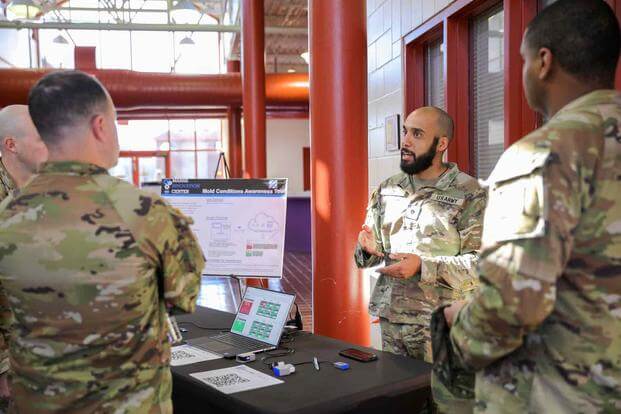As senior Army leaders wrestle with ongoing mold and other quality-of-life issues that junior enlisted troops face, one of those junior soldiers -- an infantryman coder -- is trying to help the force understand the scope of the problem at Fort Stewart, Georgia, using tech.
Spc. Salem Ezz, an infantryman assigned to 3rd Battalion, 69th Armor Regiment, 1st Brigade, 3rd Infantry Division, built a series of sensors from scratch that can track humidity in barracks and report conditions for mold in real time.
The tools, which are in the early stages of development, may be able to help commanders track the scope of mold issues at Army facilities, something several have told Military.com is a major challenge.
Read Next: The Latest Document the Military Is Hiding Behind Handling Rules: Parental Leave
After Military.com published a series of stories detailing mold issues at Fort Stewart and Fort Bragg, North Carolina, the Army launched a service-wide inspection of all of its buildings. That review wrapped up two weeks ago, with results set to be briefed to senior leaders at the end of the month, according to an official with direct knowledge of the inspection.
Army planners are still searching for solutions to fix the moldy barracks problem, drawing on a $1 billion budget per year for remediation that they say isn't enough.
Army Secretary Christine Wormuth has increasingly raised concerns that the Army cannot afford to maintain its aging barracks and build new ones in an appropriate amount of time, even discussing the issue with President Joe Biden last year behind closed doors, according to one source with direct knowledge of the meeting.
The Mold Conditions Awareness Tool developed by Ezz uses sensors to identify humidity levels and warn soldiers if those levels hit a point at which mold can breed; according to the Centers for Disease Control and Prevention, that occurs at around 50% humidity. Soldiers can also press a button on the sensor if they see mold in the vicinity. Those two simple tracking methods could theoretically eliminate a bureaucratic process of complaints being filed and received, which sometimes can take weeks or months to trigger a response.
Ezz, who pitched the idea to Army leaders in November and began placing sensors in rooms in January, is working on the system full time after his leadership discovered his passion for coding. Even after joining the Army as an infantryman, he continued his civilian education and is set to graduate college this year. The Army also sent him to an intense coding training course run by Galvanize, which can cost upward of $20,000 for civilians.
"Before I joined the Army, I played with circuit boards a lot. I would build stuff that would look at humidity and temperatures a lot cheaper than what you'd buy at the store," Ezz told Military.com in an interview. "I lived in the barracks for a while. What pushed this was the mold issue was all over social media; it's what people were talking about."
Right now, the program is in a pilot phase in just under a dozen rooms at Fort Stewart.
Ezz is aiming to have a brigade-size pilot kicked off before the end of the year, which could monitor rooms for a huge portion of troops at Fort Stewart.
In September, Military.com published an investigation on Fort Stewart that found many of the buildings its junior troops were living in were infested with mold and that the response from the garrison's leadership and workforce to clean, maintain and otherwise provide general support was minimal. Ahead of Military.com's story publishing, leadership on base had a so-called "mold stand-down" during which soldiers were briefed on room maintenance and procedures to submit formal complaints.
When that investigation was published, there were 1,450 mold-related work orders at the base, according to data provided by a spokesperson. Those work orders range from formal complaints to cleaning or maintenance requests. As of Thursday, there are 11 open mold-related work orders, according to a 3rd Infantry Division spokesperson. The Army is also set to begin a $105 million construction project building new barracks at Fort Stewart that will house 372 soldiers.
A large number of the Army barracks are suffering from mold and other infrastructure-related issues, especially those at Fort Stewart; Schofield Barracks, Hawaii; and Fort Bragg, all locations with high humidity.
Army officials have also pointed to the age of those buildings, and particularly their climate control systems, as a key problem. Many of the barracks, known as VOLAR buildings, were constructed under the Army's Project Volunteer Army program in the 1970s. Those buildings were generally built with poor ventilation and first-generation air conditioning units that are prone to leaking and fostering an environment for mold growth.
Wormuth and other Army officials have been making their way through the service's major installations touring barracks, which has already resulted in 1,100 soldiers at Fort Bragg being removed from moldy barracks. Roughly 400 of them were given a basic housing allowance, a move generally reserved for married soldiers.
Wormuth toured Schofield Barracks in January.
"I saw some barracks here at Schofield that I was not pleased to see at all," she said at a town hall last week. "This is an area that frankly we need to make more investments Army-wide. We have some problematic barracks."
-- Steve Beynon can be reached at Steve.Beynon@military.com. Follow him on Twitter @StevenBeynon.
Related: Mold Is Consuming Fort Stewart's Barracks as a Pattern Emerges Across the Army














